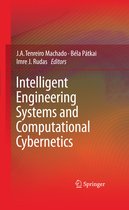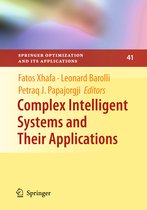Intelligent Engineering Systems and Computational Cybernetics
Afbeeldingen
Sla de afbeeldingen overArtikel vergelijken
- Engels
- Hardcover
- 9781402086779
- 11 februari 2009
- 460 pagina's
Samenvatting
Engineering practice often has to deal with complex systems of multiple variable and multiple parameter models almost always with strong non-linear coupling. The conventional analytical techniques-based approaches for describing and predicting the behaviour of such systems in many cases are doomed to failure from the outset, even in the phase of the construction of a more or less appropriate mathematical model. The best paradigm exemplifying this situation may be the classic perturbation theory: the less significant the achievable correction, the more work has to be invested to obtain it.
A further important component of machine intelligence is a kind of “structural uniformity” giving room and possibility to model arbitrary particular details a priori not specified and unknown. This idea is similar to the ready-to-wear industry, which introduced products, which can be slightly modified later on in contrast to tailor-made creations aiming at maximum accuracy from the beginning. These subsequent corrections can be carried out by machines automatically. This “learning ability” is a key element of machine intelligence.
The past decade confirmed that the view of typical components of the present soft computing as fuzzy logic, neural computing, evolutionary computation and probabilistic reasoning are of complementary nature and that the best results can be applied by their combined application.
Today, the two complementary branches of Machine Intelligence, that is, Artificial Intelligence and Computational Intelligence serve as the basis of Intelligent Engineering Systems. The huge number of scientific results published in Journal and conference proceedings worldwide substantiates this statement. The present book contains several articles taking different viewpoints in the field of intelligent systems.
Engineering practice often has to deal with complex systems of multiple variable and multiple parameter models almost always with strong non-linear coupling. The conventional analytical techniques-based approaches for describing and predicting the behaviour of such systems in many cases are doomed to failure from the outset, even in the phase of the construction of a more or less appropriate mathematical model. These approaches normally are too categorical in the sense that in the name of “modelling accuracy” they try to describe all the structural details of the real physical system to be modelled. This can significantly increase the intricacy of the model and may result in a enormous computational burden without achieving considerable improvement of the solution. The best paradigm exemplifying this situation may be the classic perturbation theory: the less significant the achievable correction, the more work has to be invested to obtain it.
A further important component of machine intelligence is a kind of “structural uniformity” giving room and possibility to model arbitrary particular details a priori not specified and unknown. This idea is similar to the ready-to-wear industry, which introduced products, which can be slightly modified later on in contrast to tailor-made creations aiming at maximum accuracy from the beginning. These subsequent corrections can be carried out by machines automatically. This “learning ability” is a key element of machine intelligence.
The past decade confirmed that the view of typical components of the present soft computing as fuzzy logic, neural computing, evolutionary computation and probabilistic reasoning are of complementary nature and that the best results can be applied by their combined application.
Today, the two complementary branches of Machine Intelligence, that is, Artificial Intelligence and Computational Intelligence serve as the basis of Intelligent Engineering Systems. Thehuge number of scientific results published in Journal and conference proceedings worldwide substantiates this statement. The present book contains several articles taking different viewpoints in the field of intelligent systems.
Productspecificaties
Inhoud
- Taal
- en
- Bindwijze
- Hardcover
- Oorspronkelijke releasedatum
- 11 februari 2009
- Aantal pagina's
- 460
- Illustraties
- Nee
Betrokkenen
- Hoofdredacteur
- J.A. Tenreiro Machado
- Tweede Redacteur
- Bela Patkai
- Co Redacteur
- Imre J. Rudas
- Hoofduitgeverij
- Springer-Verlag New York Inc.
Overige kenmerken
- Editie
- 2009 ed.
- Extra groot lettertype
- Nee
- Product breedte
- 159 mm
- Product hoogte
- 32 mm
- Product lengte
- 235 mm
- Studieboek
- Nee
- Verpakking breedte
- 159 mm
- Verpakking hoogte
- 32 mm
- Verpakking lengte
- 235 mm
- Verpakkingsgewicht
- 839 g
EAN
- EAN
- 9781402086779
Kies gewenste uitvoering
Prijsinformatie en bestellen
De prijs van dit product is 163 euro en 99 cent. De meest getoonde prijs is 173 euro en 99 cent. Je bespaart 6%.- Bestellen en betalen via bol
- Prijs inclusief verzendkosten, verstuurd door Roelants
- 30 dagen bedenktijd en gratis retourneren
- Wettelijke garantie via Roelants
Rapporteer dit artikel
Je wilt melding doen van illegale inhoud over dit artikel:
- Ik wil melding doen als klant
- Ik wil melding doen als autoriteit of trusted flagger
- Ik wil melding doen als partner
- Ik wil melding doen als merkhouder
Geen klant, autoriteit, trusted flagger, merkhouder of partner? Gebruik dan onderstaande link om melding te doen.









